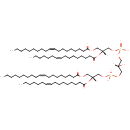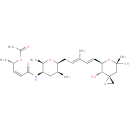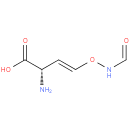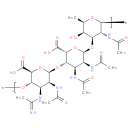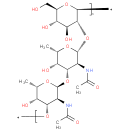
Search Results for compounds
Searching compounds for
returned 4373 results.
Displaying compounds 2871 - 2880 of
4373 in total
CL(19:1(9Z)/16:1(9Z)/19:1(9Z)/16:1(9Z)) (PAMDB007017)
IUPAC:
[(2R)-2-[(9Z)-hexadec-9-enoyloxy]-3-[(9Z)-nonadec-9-enoyloxy]propoxy][3-({[(2R)-2-[(9Z)-hexadec-9-enoyloxy]-3-[(9Z)-nonadec-9-enoyloxy]propoxy](hydroxy)phosphoryl}oxy)-2-hydroxypropoxy]phosphinic acid
CAS: Not Available
Description: CL(19:1(9Z)/16:1(9Z)/19:1(9Z)/16:1(9Z)) is a cardiolipin (CL). Cardiolipins are sometimes called a 'double' phospholipid because they have four fatty acid tails, instead of the usual two. CL(19:1(9Z)/16:1(9Z)/19:1(9Z)/16:1(9Z)) contains two chains of (9Z-nonadecenoyl) at the C1 and C3 positions, two chains of (9Z-hexadecenoyl) at the C2 and C4 positions. While the theoretical charge of cardiolipins is -2, under normal physiological conditions (pH near 7), the molecule may carry only one negative charge. In prokaryotes such as Pseudomonas aeruginosa, the enzyme known as diphosphatidylglycerol synthase catalyses the transfer of the phosphatidyl moiety of one phosphatidylglycerol to the free 3'-hydroxyl group of another, with the elimination of one molecule of glycerol. In Pseudomonas aeruginosa, which acylates its glycerophospholipids with acyl chains ranging in length from 12 to 19 carbons and possibly containing an unsaturation, or a cyclopropane group more than 100 possible CL molecular species are theoretically possible. Pseudomonas aeruginosa membranes consist of ~5% cardiolipin (CL), 20-25% phosphatidylglycerol (PG), and 70-80% phosphatidylethanolamine (PE) as well as smaller amounts of phosphatidylserine (PS). CL is distributed between the two leaflets of the bilayers and is located preferentially at the poles and septa in Pseudomonas aeruginosa and other rod-shaped bacteria. It is known that the polar positioning of the proline transporter ProP and the mechanosensitive ion channel MscS in Pseudomonas aeruginosa is dependent on CL. It is believed that cell shape may influence the localization of CL and the localization of certain membrane proteins.
CL(19:iso/10:0(3-OH)/19:iso/10:0(3-OH)) (PAMDB007019)
IUPAC:
Not Available
CAS: Not Available
Description: CL(19:iso/10:0(3-OH)/19:iso/10:0(3-OH)) is a cardiolipin (CL). Cardiolipins are sometimes called a 'double' phospholipid because they have four fatty acid tails, instead of the usual two. CL(19:iso/10:0(3-OH)/19:iso/10:0(3-OH)) contains two chains of 17-methylocatdecanoic acid at the C1 and C3 positions, two chains of 3-hydroxydecanoic acid at the C2 and C4 positions. While the theoretical charge of cardiolipins is -2, under normal physiological conditions (pH near 7), the molecule may carry only one negative charge. In prokaryotes such as Pseudomonas aeruginosa, the enzyme known as diphosphatidylglycerol synthase catalyses the transfer of the phosphatidyl moiety of one phosphatidylglycerol to the free 3'-hydroxyl group of another, with the elimination of one molecule of glycerol. In Pseudomonas aeruginosa, which acylates its glycerophospholipids with acyl chains ranging in length from 12 to 19 carbons and possibly containing an unsaturation, or a cyclopropane group more than 100 possible CL molecular species are theoretically possible. Pseudomonas aeruginosa membranes consist of ~5% cardiolipin (CL), 20-25% phosphatidylglycerol (PG), and 70-80% phosphatidylethanolamine (PE) as well as smaller amounts of phosphatidylserine (PS). CL is distributed between the two leaflets of the bilayers and is located preferentially at the poles and septa in Pseudomonas aeruginosa and other rod-shaped bacteria. It is known that the polar positioning of the proline transporter ProP and the mechanosensitive ion channel MscS in Pseudomonas aeruginosa is dependent on CL. It is believed that cell shape may influence the localization of CL and the localization of certain membrane proteins.
CL(19:iso/10:0/19:iso/10:0) (PAMDB007020)
IUPAC:
Not Available
CAS: Not Available
Description: CL(19:iso/10:0/19:iso/10:0) is a cardiolipin (CL). Cardiolipins are sometimes called a 'double' phospholipid because they have four fatty acid tails, instead of the usual two. CL(19:iso/10:0/19:iso/10:0) contains two chains of 17-methylocatdecanoic acid at the C1 and C3 positions, two chains of decanoic acid at the C2 and C4 positions. While the theoretical charge of cardiolipins is -2, under normal physiological conditions (pH near 7), the molecule may carry only one negative charge. In prokaryotes such as Pseudomonas aeruginosa, the enzyme known as diphosphatidylglycerol synthase catalyses the transfer of the phosphatidyl moiety of one phosphatidylglycerol to the free 3'-hydroxyl group of another, with the elimination of one molecule of glycerol. In Pseudomonas aeruginosa, which acylates its glycerophospholipids with acyl chains ranging in length from 12 to 19 carbons and possibly containing an unsaturation, or a cyclopropane group more than 100 possible CL molecular species are theoretically possible. Pseudomonas aeruginosa membranes consist of ~5% cardiolipin (CL), 20-25% phosphatidylglycerol (PG), and 70-80% phosphatidylethanolamine (PE) as well as smaller amounts of phosphatidylserine (PS). CL is distributed between the two leaflets of the bilayers and is located preferentially at the poles and septa in Pseudomonas aeruginosa and other rod-shaped bacteria. It is known that the polar positioning of the proline transporter ProP and the mechanosensitive ion channel MscS in Pseudomonas aeruginosa is dependent on CL. It is believed that cell shape may influence the localization of CL and the localization of certain membrane proteins.
FR901464 (PAMDB100004)
IUPAC:
(2S,3Z)-5-{[(2R,3R,5S,6S)-6-{(2E,4E)-5-[(3R,4R,5R,7S)-4,7-Dihydroxy-7-methyl-1,6-dioxaspiro[2.5]oct-5-yl]-3-methyl-2,4-pentadien-1-yl}-2,5-dimethyltetrahydro-2H-pyran-3-yl]amino}-5-oxo-3-penten-2-yl a cetate
CAS: Not Available
Description: An oxaspiro compound with potent anticancer activity that lowers the mRNA levels of oncogenes and tumour supressor genes. It is isolated from Pseudomonas sp. no.2663.
2-amino-4-formylaminooxy-but-3E-enoic acid (PAMDB100005)
IUPAC:
(2S,3E)-2-Amino-4-(formamidooxy)-3-butenoic acid
CAS: Not Available
Description: A natural product found particularly in Pseudomonas fluorescens and Pseudomonas fluorescens Pf0-1.
syringolin A (PAMDB100006)
IUPAC:
2-[[1-[[(3E,9Z)-2,7-dioxo-5-propan-2-yl-1,6-diazacyclododeca-3,9-dien-8-yl]amino]-3-methyl-1-oxobutan-2-yl]carbamoylamino]-3-methylbutanoic acid
CAS: Not Available
Description: A syrbactin that has a (3E,9E)-2,7-dioxo-1,6-diazacyclododeca-3,9-diene skeleton that is substituted by an isopropyl group at position 5 and by a [(2S)-2-({[(1S)-1-carboxy-2-methylpropyl]carbamoyl}amino)-3-methylbutanoyl]nitril
P. aeruginosa immunotype 3 O-specific polysaccharide (PAMDB100007)
IUPAC:
Not Available
CAS: Not Available
Description: A polysaccharide antigen composed of a backbone of linear trisaccharide repeating units that are joined to each other via β-(1→4)-linkages. The O-specific side chain of Pseudomonas aeruginosa immunotype 3 lipopolysaccharide.
P. aeruginosa serotype O11 O-specific polysaccharide (PAMDB100008)
IUPAC:
Not Available
CAS: Not Available
Description: A polysaccharide epitope composed of a backbone of linear trisaccharide repeating units that are joined to each other via β-(1→4)-linkages. The O-polysaccharide portion of the lipopolysaccharide from Pseudomonas aeruginosa serotyp
acetylpyruvic acid (PAMDB100009)
IUPAC:
2,4-dioxopentanoic acid
CAS: Not Available
Description: A dioxo monocarboxylic acid that is pentanoic acid carrying two oxo groups at positions 2 and 4.
N-(3-oxododecanoyl)-L-homoserine lactone (PAMDB100010)
IUPAC:
3-oxo-N-[(3S)-2-oxotetrahydrofuran-3-yl]dodecanamide
CAS: Not Available
Description: An N-acyl-L-homoserine lactone having 3-oxododecanoyl as the acyl substituent.
